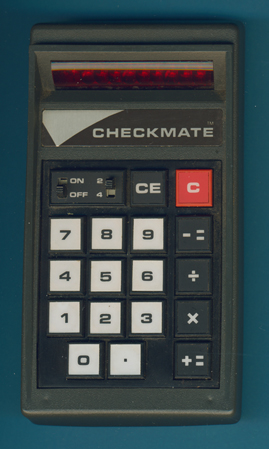
DATAMATH CALCULATOR MUSEUM
 |
DATAMATH CALCULATOR MUSEUM |
Litronix Checkmate (Second Version)
| Date of introduction: | 1973 | Display technology: | LED-modules |
| New price: | Display size: | 8 | |
| Size: | 5.4" x 3.1" x 1.4" 138 x 78 x 36 mm3 |
||
| Weight: | 8.0 ounces, 227 grams | Serial No: | 22300 |
| Batteries: | 3*AA NiCd cells | Date of manufacture: | mth 06 year 1973 |
| AC-Adapter: | Origin of manufacture: | USA | |
| Precision: | 12 | Integrated circuits: | LIT-019 |
| Memories: | |||
| Program steps: | Courtesy of: | Joerg Woerner |

![]()
 Litronix,
Inc., (Cupertino, CA) was an early light-emitting diode (LED) company that
became a leading supplier of displays for handheld calculators and digital
watches (e.g. the Hamilton Pulsar line).
Litronix,
Inc., (Cupertino, CA) was an early light-emitting diode (LED) company that
became a leading supplier of displays for handheld calculators and digital
watches (e.g. the Hamilton Pulsar line).

 The
Checkmate was the first portable electronic calculator developed and
manufactured by Litronix While the original
design of the Checkmate was using a Texas Instruments Klixon™
keypad, did we locate with this second version of the Checkmate a keyboard
manufactured by Wild Rover Corp.
The
Checkmate was the first portable electronic calculator developed and
manufactured by Litronix While the original
design of the Checkmate was using a Texas Instruments Klixon™
keypad, did we locate with this second version of the Checkmate a keyboard
manufactured by Wild Rover Corp.
![]()
 The printed circuit board (PCB) of the
Checkmate is centered around a LIT-019 calculator circuit, discrete display
drivers (the three white ceramic housings are current limiting resistors
manufactured by Beckman), and an additional PCB for the LED display.
The printed circuit board (PCB) of the
Checkmate is centered around a LIT-019 calculator circuit, discrete display
drivers (the three white ceramic housings are current limiting resistors
manufactured by Beckman), and an additional PCB for the LED display.
![]() The
display board makes use of three modules with 3 digits, each and one additional
discrete LED - most likely all manufactured by Litronix.
The
display board makes use of three modules with 3 digits, each and one additional
discrete LED - most likely all manufactured by Litronix.
Not sure if you noticed already the unusual lettering of the decimal switch above the [-=]
key. Instead the usual 0-2 selection it gives a 2-4 selection. The Checkmate is
one of the few portable calculators without floating point operation.
The label on the back gives an example for calculations with small numbers with
the decimal switch set to "4":
.17 : 9 = .0188
The Checkmate was later replaced with the Checkmate 1002 assembled in Malaysia.
If you have additions to the above article please email: joerg@datamath.org.
© Joerg Woerner, June 25, 2019. No reprints without written permission.